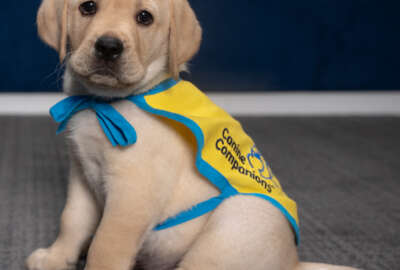
Service dogs for veterans with disabilities takes training
Veterans with disabilities often benefit from service dogs. Service dogs just don't happen. They require careful training. The PenFed Foundation has information on...
Veterans with disabilities often benefit from service dogs. Service dogs just don’t happen. They require careful training. The PenFed Foundation has information on what it takes to raise and train a service dog from a puppy. To learn more, the Federal Drive with Tom Temin spoke with James Schenck, CEO of the PenFed Foundation and Andrea McCarren, the president of the PenFed Foundation.
Interview Transcript:
Tom Temin All right. First of all, give us a sense of what the demand is from veterans. 9 million veterans are served by the Veterans Affairs Department and many of them do need dogs. What are the demand signals you’re getting?
Andrea McCarren That’s such a great question, Tom. And this is why PenFed Foundation has partnered with Canine Companions, because the wait time for a veteran in need of a service dog is up to two years. The demand for these highly trained service dogs is greater than ever before post-pandemic with the withdrawal of American troops from Afghanistan. We just have such a dramatic need. What is the shortage, though? Is volunteer puppy raisers like me who get these puppies at eight weeks of age socialize them primarily up to 18 months of age, and then they go in for six months of very formal training to learn how to turn on and off light switches, how to pick things up off the floor, how to open and close a refrigerator, all kinds of life changing skills that can really improve the independence and lifestyle of a veteran.
Tom Temin Yeah, because you mentioned a lot of specific tasks that these dogs are capable of learning. I think maybe service dogs have gotten a bad name because of emotional support, peacocks and things that people try to get on airplanes. But this is really a practical application.
Andrea McCarren Very much so. They’re fully trained service dogs are nothing like emotional support animals except for the fact that, yes, they provide wonderful companionship for a veteran. But studies have shown that veterans do not need a lot of the medications that they are prescribed once they get a service dog in their life. It really is a dramatic change for them and their entire family. At PenFed, one of the first puppies I raise, pilot who’s with me right now is number six for me. But Maverick, which is the first dog I raised at PenFed, went to an Air Force veteran in Massachusetts who had such profound injuries that his wife had to quit her job and become his full time caregiver. When Maverick joined their family, Josh Gage, the veteran’s wife, was able to go back to school and she immediately was able to restart her career. And his life is completely different. The dog is trained to go get his cane, to fetch his medication bag, to open and close doors for him. And what’s a very important skill that’s taught these service dogs is called nightmare interruption. If a veteran is having night terrors, which is very common for vets who have been through combat deployments, the dog is trained to pull down their comforter, turn on the lights, and then climb in bed and lie on top of them until they are awake or calmed down and they realize everything’s okay.
Tom Temin All right. Sounds like a pretty able animal. And James, you are a canine companion hero award winner. What does PenFed writ large as interest in this? And tell us more about the connection you have with this dog organization.
James Schenck Providing veterans freedom and independence, a higher quality of life is so important for all of us. PenFed is just one firm, and my message is really to encourage all firms to raise a puppy in training. Canine Companions gives us that forum and gives us the professionalism of the organization in order to do it. But what it really takes is just an individual at once, the volunteer and employers that will let their employees bring these dogs to the workplace. Whether it’s a staff meeting, to a board meeting, it has provided an amazing positive experience for my entire firm these past five years. As Andrea says, they come to work every day, they socialize with the different employees, they reinforce the culture of service, doing something for others, and they reinforce a culture of kindness and respect. I’ve never been in a meeting in which we had a service dog or a puppy in training in which the atmosphere hasn’t been extremely positive. So I encourage all CEOs across America to learn more and to bring a service dog into their workplace.
Tom Temin What’s your experience in, say, the Veterans Affairs Department or federal agencies letting, and they hire a lot of veterans, letting dogs come to work. If indeed people are going to work, they are at VA, that’s for sure.
Andrea McCarren The law protects them. And what’s wonderful about the D.C., Maryland, Virginia area for puppy raisers like me, is the law also covers service dogs in training, not just service dogs. So when I’m training him, if I’m going to a federal agency, if I’m going to a grocery store, a restaurant, we are covered by the law to be able to socialize the dog there.
Tom Temin Good point. We’re speaking with Andrea McCarren. She’s president of the PenFed Foundation. And James Schenck as CEO of the PenFed Credit Union and of the PenFed Foundation. And if someone wants to train a dog, what are the breeds they’re likely to get? And how long does it take?
Andrea McCarren It takes about 18 months for a puppy raiser to volunteer their time and socialize the dog and teach it basic obedience commands. What your listeners don’t see right now is this incredibly adorable nine week old yellow lab golden retriever cross puppy.
Tom Temin I see it.
Andrea McCarren As my newest recruit, you are lucky enough to see.
Tom Temin I can see him. Yeah.
Andrea McCarren But it’s a very interesting question, because canine companions primarily uses Labrador Retrievers and Golden Retrievers or crosses between the two. Anyone who knows anything about dogs knows that labs aim to please. They’re extremely determined, very smart. And Golden Retrievers are also wonderful dogs, but they have kind of a mushy temperament. And so the combination of the two is extremely powerful. However, there are also going to be veterans who have allergies to dogs, which is why standard poodles are also used fairly rarely, but they are used so all veterans in need can be covered.
Tom Temin This is one moment I wish this was television because people should only see that cute dog. What about the Belgian Malinois, which a lot of service members have used as war dogs and they don’t translate well to the service end after veterans.
Andrea McCarren Belgian Malinois are such incredibly smart dogs and they are used, as you know, by a lot of federal agencies. And I believe the Secret Service uses them at the White House. They have a very different temperament. Labradors and Goldens are really raised for their sweetness and just being gentle, good souls, whereas the Belgian Malinois are much more driven and they have what’s known as a prey drive. They are trained not just to work hard but to fight. And that’s just not something we would encourage in a service dog.
Tom Temin Yeah, imagine taking one on the metro or something and somebody comes at you and you’ve got a Malinois. Well, for the veteran that is able to obtain one of these service dogs, what’s incumbent upon him or her to make sure it stays trained and to make sure it stays emotionally and physically cared for.
Andrea McCarren That’s such a great question. And canine companions, first of all, canine companions in any reputable service dog organization will provide these highly trained dogs that have more than 40 skills free of charge to veterans. It really pains me, Tom, when I hear that somebody has paid up to 35 or $50,000 for a service dog. There are great organizations out there, and Canine Companions also provides essentially lifelong service to those veterans. Meaning they will check in with them, they are always available. They are very professional trainers, and that’s how they keep those commands fresh.
Tom Temin And if someone wants to raise a dog for the purpose of supplying it to a veteran. The training itself you have to know how to do.
Andrea McCarren That’s the wonderful thing that we’re really trying to impart to the public. You do not need any dog training experience. You simply need a willingness to open your home and your heart. And an employer like James, who will allow you to bring a dog to the office. And research shows that having a dog in the office, particularly a service dog with a mission, lowers blood pressure among staff, increases productivity. And as James mentioned, it’s so wonderful for teamwork. I’ve raised so many of these dogs and people are just so thrilled to be a part of something life changing and very often lifesaving for our military.
Tom Temin It must be tough, though, to raise a dog for 18 months and then give it away.
Andrea McCarren That’s the question I get literally every day, Tom. And it is very difficult. But clearly someone needs them more than I do. And what better way to express our gratitude to our military heroes than raising a service dog? I often tell people I didn’t serve in the military. I haven’t been in combat, but I can raise and train a service dog for someone who has.
Tom Temin And for someone that wants to raise a service dog or train a service dog. Can you do that in the presence of other pets, other dogs that might be in the house or parrots or something?
Andrea McCarren It’s actually preferable to have another animal in the household because that’s just one more socialization experience for these future service dogs. In fact, when these dogs go in for their six months of formal training, after the 18 months with their puppy raisers, one of the things that is such a challenge for so many dogs is they have resident cats in the facility. And if there’s a dog who has not been exposed to a cat, the dog will just lose their mind. Whereas my dogs have done pretty well. Because they have coexisted peacefully.
Tom Temin You’re tempting me. Andrea McCarron is president of the PEN Fed Foundation. James Shank is CEO. Thanks so much for joining me.
Andrea McCarren Thanks so much. If anyone wants information, please send them to pen Fed Foundation dot org. All right. Thanks, Tom.
Copyright © 2025 Federal News Network. All rights reserved. This website is not intended for users located within the European Economic Area.
Tom Temin is host of the Federal Drive and has been providing insight on federal technology and management issues for more than 30 years.
Follow @tteminWFED





